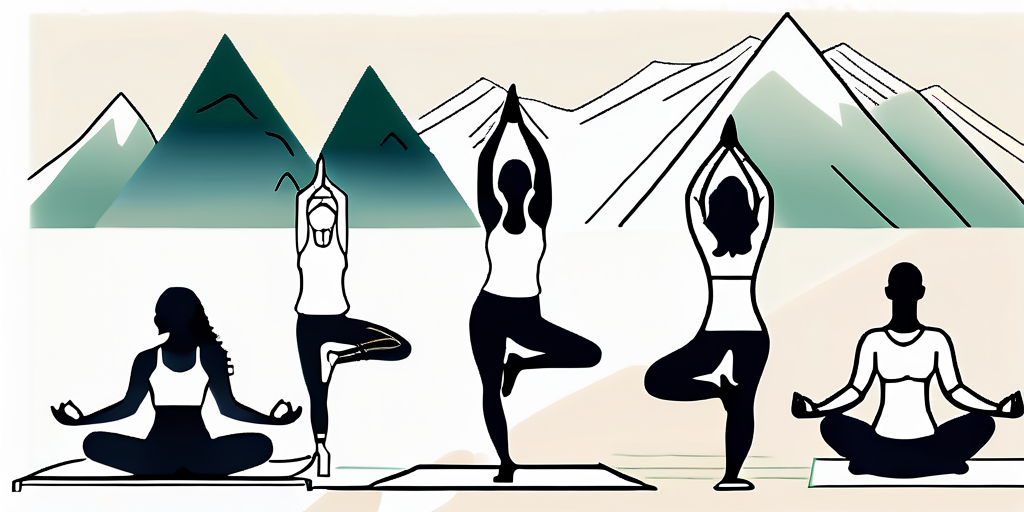Yoga is a wonderful practice that offers a multitude of physical, mental, and emotional benefits. Whether you are a beginner or an experienced yogi, having the right equipment can greatly enhance your yoga journey. In this article, we will explore the basics of yoga, the essential equipment you need, how to create your own yoga space at home, how to incorporate technology into your practice, and tips for maintaining your yoga equipment.
Understanding the Basics of Yoga
Before diving into the world of yoga equipment, it's important to understand the basics of yoga. At its core, yoga is a holistic practice that combines physical postures (asanas), breathing techniques (pranayama), and meditation to promote overall well-being. Additionally, yoga is rooted in a philosophy that aims to cultivate self-awareness, mindfulness, and inner peace.

Yoga is not just a form of exercise; it is a way of life. It originated in ancient India thousands of years ago and has since spread across the globe, gaining popularity for its numerous physical and mental benefits. The word "yoga" itself means "union" or "to join" in Sanskrit, reflecting the practice's goal of uniting the mind, body, and spirit.
The Philosophy Behind Yoga
The philosophy behind yoga encompasses various principles and concepts. One of the key foundations of yoga is the belief that the mind, body, and spirit are interconnected. Through yoga, practitioners strive to achieve a harmonious balance between these aspects of their being. The practice also emphasizes the importance of living in the present moment and embracing gratitude.
In addition to physical postures and breathing techniques, yoga incorporates ethical guidelines known as the Yamas and Niyamas. These principles guide practitioners in their interactions with themselves, others, and the world around them. The Yamas include concepts such as non-violence, truthfulness, and non-attachment, while the Niyamas focus on self-discipline, contentment, and self-study.
Yoga is not limited to the mat; it extends beyond the physical practice. It encourages individuals to cultivate mindfulness and self-awareness in their everyday lives, leading to a greater sense of clarity, compassion, and inner peace.
Different Types of Yoga
There are several different types of yoga, each with its own unique focus and approach. Some popular forms include Hatha, Vinyasa, Ashtanga, and Kundalini. It's worth exploring these different styles to find one that resonates with you and aligns with your fitness goals and preferences.
Hatha yoga is a gentle and slower-paced practice that focuses on basic postures and breath control. It is a great starting point for beginners who want to build strength and flexibility while also calming the mind.
Vinyasa yoga, on the other hand, is a more dynamic and flowing style that synchronizes movement with breath. It offers a cardiovascular workout while also promoting mindfulness and body awareness.
Ashtanga yoga follows a specific sequence of postures and is known for its challenging and physically demanding nature. It is a disciplined practice that builds strength, flexibility, and stamina.
Kundalini yoga incorporates dynamic movements, breathwork, chanting, and meditation to awaken the dormant spiritual energy within. It focuses on the balance and alignment of the chakras, or energy centers, in the body.
These are just a few examples of the diverse range of yoga styles available. Each type offers its own unique benefits and can cater to different individuals' needs and preferences. Exploring different styles can help you discover the one that resonates with you and supports your overall well-being.
Essential Yoga Equipment
When it comes to yoga equipment, there are a few essential items that can enhance your practice and ensure your comfort and safety.
Yoga is a practice that has been around for centuries, originating in ancient India. It combines physical postures, breathing exercises, and meditation to promote physical and mental well-being. Whether you are a beginner or an experienced yogi, having the right equipment can make a significant difference in your practice.
Choosing the Right Yoga Mat
A yoga mat is a must-have piece of equipment for any yogi. When selecting a yoga mat, it's important to consider factors such as thickness, grip, and material. A thicker mat provides more cushioning, making it ideal for practitioners with joint sensitivities. Look for a mat with a non-slip surface to prevent any accidental slips or slides during your practice. Additionally, opt for a mat made from eco-friendly materials to support sustainability efforts.
Imagine stepping onto your yoga mat, feeling the softness beneath your feet. The thickness of the mat provides a comfortable cushion, allowing you to fully immerse yourself in your practice. The non-slip surface ensures that you can confidently move through your poses without worrying about losing your balance. And knowing that your mat is made from eco-friendly materials gives you peace of mind, knowing that you are contributing to the preservation of our planet.
Importance of Yoga Blocks and Straps
Yoga blocks and straps can be incredibly beneficial for practitioners of all levels. Blocks provide support and stability in challenging postures, allowing you to deepen your stretches and improve alignment. Straps, on the other hand, assist with flexibility by helping you reach further in certain poses. These props are especially useful for beginners or individuals with limited flexibility.
Imagine using a yoga block to support your body as you attempt a challenging balancing pose. The block provides a stable foundation, allowing you to focus on your alignment and gradually build strength and flexibility. And when you use a strap to extend your reach in a forward fold, you can feel your muscles lengthening and your body opening up in ways you never thought possible.
Yoga Clothing: What to Consider
While yoga can be practiced in any comfortable clothing, investing in proper yoga attire can enhance your experience. Look for clothing made from breathable and stretchy materials that allow for ease of movement. Opt for moisture-wicking fabrics to keep you cool and dry during your practice. Choose clothing that fits well and makes you feel comfortable and confident.
Imagine wearing yoga clothing that feels like a second skin, allowing you to move freely and effortlessly. The breathable and stretchy materials ensure that you can flow through your practice without any restrictions. And with moisture-wicking fabrics, you can stay cool and dry even during the most intense and sweat-inducing sequences. Not only does proper yoga attire enhance your physical comfort, but it also boosts your confidence, allowing you to fully immerse yourself in the practice.
Creating Your Yoga Space at Home
Having a dedicated yoga space at home can enhance the tranquility and focus of your practice. Here are a few tips on how to create your own yoga oasis:

Selecting the Perfect Spot
Find a quiet and clutter-free area in your home where you can roll out your mat and practice without distractions. Ideally, this space should have good natural light and ventilation. If you have limited space, consider using a folding mat or designating a specific time for your practice when you can rearrange furniture to make room.
When selecting the perfect spot, it's important to consider the energy flow in the room. Feng shui principles suggest that the ideal yoga space should be located in the east or northeast corner of your home. This direction is associated with new beginnings and spiritual growth, making it an ideal location for your practice.
Additionally, you may want to consider the view from your yoga space. If possible, position your mat near a window overlooking a garden or natural landscape. Connecting with nature can enhance your practice and bring a sense of peace and serenity.
Setting the Mood for Yoga
Creating a calming and peaceful ambiance can greatly enhance your yoga experience. Consider playing soft, soothing music or nature sounds to create an atmosphere of serenity. You may also want to incorporate scented candles or essential oils with relaxing aromas. Dimming the lights or using soft lighting can further enhance the mood of your practice.
Another way to set the mood is by incorporating elements of nature into your yoga space. Place potted plants or fresh flowers nearby to bring a sense of vitality and connection to the natural world. You can also hang tapestries or artwork depicting serene landscapes or spiritual symbols to create a visually pleasing and inspiring environment.
Furthermore, consider adding props and accessories to your yoga space to enhance your practice. Invest in a high-quality yoga mat that provides adequate cushioning and support. You can also include bolsters, blocks, and straps to assist with challenging poses and deepen your stretches. Having these props readily available will make your practice more comfortable and enjoyable.
Lastly, don't forget to keep your yoga space clean and organized. Clutter can be distracting and disrupt the flow of energy. Use storage baskets or shelves to keep your yoga props neatly organized and out of sight when not in use. A clean and tidy space will help create a sense of calm and promote a focused mind.
Incorporating Technology in Your Yoga Practice
Technology has become an integral part of our lives, and it can also enhance your yoga practice. Here are a few ways to leverage technology for a more enriching experience.

When it comes to incorporating technology into your yoga practice, the possibilities are endless. From useful yoga apps and online platforms to the role of music in yoga, there are various ways to enhance your practice and make it even more enjoyable.
Useful Yoga Apps and Online Platforms
There are numerous yoga apps and online platforms available that offer classes, guided meditations, and even personalized yoga routines. These resources provide convenience and flexibility, allowing you to practice yoga anytime and anywhere.
With just a few taps on your smartphone or clicks on your computer, you can access a wide range of yoga classes taught by experienced instructors. Whether you prefer a gentle flow, a power yoga session, or a restorative practice, there is an app or platform that caters to your specific needs.
Furthermore, some apps and platforms offer features like progress tracking, allowing you to monitor your growth and improvement over time. You can set goals, track your practice hours, and even receive personalized recommendations based on your preferences and skill level.
Exploring different apps and platforms is a great way to find the one that suits your needs and preferences. Some popular options include YogaGlo, Down Dog, and Glo, each offering a unique set of features and classes to enhance your yoga journey.
The Role of Music in Yoga
Music can have a profound impact on our emotions and state of mind. Many practitioners find that incorporating music into their yoga practice enhances the overall experience.
When choosing music for your yoga practice, it's important to consider the genre and style that resonates with you. Some practitioners prefer soothing and calming melodies, while others enjoy more upbeat and energizing tunes. Experimenting with different genres and styles can help you find the perfect soundtrack that complements the flow and energy of your practice.
There are various ways to incorporate music into your yoga practice. You can create playlists specifically tailored to different types of yoga sessions or use pre-made playlists curated by yoga instructors or music enthusiasts. Some apps and platforms even offer built-in music options that sync with your practice, creating a seamless and immersive experience.
Remember, the key is to choose music that enhances your practice rather than distracts from it. The right music can help you find a deeper connection with your body and breath, allowing you to fully immerse yourself in the present moment.
So, whether you're flowing through a Vinyasa sequence, holding a challenging pose, or finding stillness in meditation, incorporating technology and music into your yoga practice can elevate your experience and help you cultivate a deeper mind-body connection.
Maintaining Your Yoga Equipment
Proper care and maintenance of your yoga equipment ensure its longevity and effectiveness. Here are some tips to keep your items in top condition.
Cleaning and Storing Your Yoga Mat
Regularly clean your yoga mat to remove sweat, dirt, and bacteria buildup. Follow the manufacturer's instructions for cleaning guidance. Avoid exposing your mat to harsh chemicals or direct sunlight, as this may degrade its quality. Store your mat in a cool and dry place to prevent moisture damage.
Caring for Your Yoga Clothes
To keep your yoga clothes looking and feeling their best, wash them in mild detergent and cold water. Avoid using fabric softeners, as they can hinder the moisture-wicking properties of the fabric. Allow your clothes to air dry or use the gentle cycle on your dryer. Taking proper care of your yoga clothes will ensure their longevity and functionality.
In conclusion, practicing yoga offers numerous benefits for your mind, body, and spirit. By investing in the right equipment, creating a serene practice space, leveraging technology, and maintaining your yoga equipment, you can enhance your overall yoga experience. Whether you are a beginner or an advanced practitioner, having the right tools and a harmonious environment can facilitate a deeper connection with yourself and the practice of yoga.




